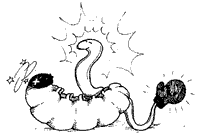 |
In The Lawn
White grubs, Wireworms, Armyworms, Japanese beetle larvae, Billbugs, June beetles, Asiatic garden beetles, Oriental beetles, Sod webworms, Leatherjackets/Crane flies, mole crickets, and Flea larva. For most of the lawn grubs, especially the Japanese beetle grub, apply nematodes in the late summer or in mid-spring when the grubs are likely to be most active.
Predatory nematodes work well in concert with the more long term natural insecticide called \"milky spore disease\". This bacteria (Bacillus pop...) can take 3 to 5 years to become numerous enough to control grubs in the lawn, but once established, it is effective for up to 15 years. The predatory nematodes can be used for the short term solution while you wait for the milky spore disease to get established (see tip sheet on milky spore disease).
In The Flower Garden
Cutworms, Root maggots, Flea Beetles, Black Vine Weevil, Mole crickets, Rose Chafer, Masked chafer, European chafer, Whitefringed beetles, fungus gnat, Iris borer.
In The Vegetable Garden
Cutworms, (For controlling cutworms apply nematodes just before setting out transplants;) Root maggots, Squash Vine Borer, Cucumber beetles, Wireworms, Flea Beetles, Corn earworms, Onion maggot, Carrot Weevil, Mole crickets, Strawberry root weevil, Cabbage root maggots, Citrus weevils. .
In Trees and Shrubs
Codling Moth on apple trees; Gypsy moth, and Borers -- while the product has not been fully approved for controlling borers, many gardeners around the country have found success using these predatory nematodes to contorl borers already imbedded in the stem or branch of a tree or shrub. The extension service in Colorado has been successful controlling raspberry crown borers. Gardeners in Florida have been using them with some success to control leaf miners after they have imbedded themselves in the leaves of beets and such. Watch for new research in this area.
Note - predatory nematodes will not control aphids, mites, white flies, slugs, or harmful nematodes such as the rootknot nematode.

